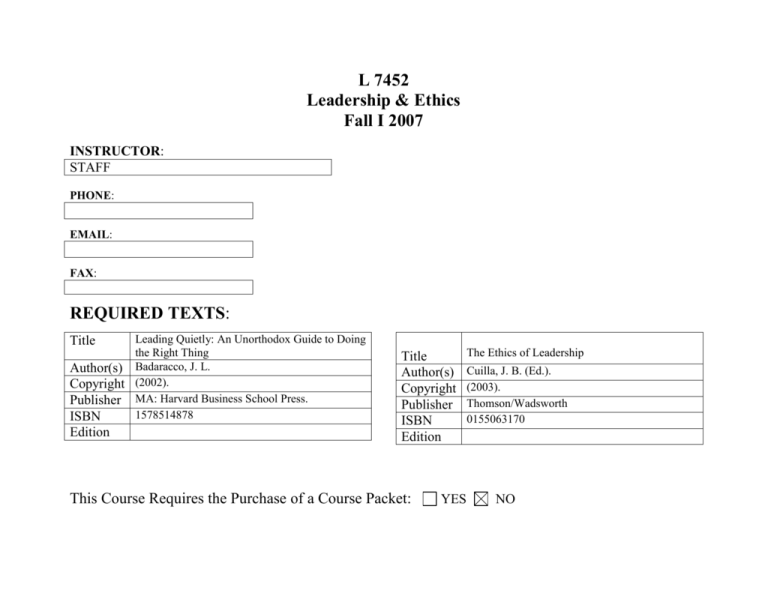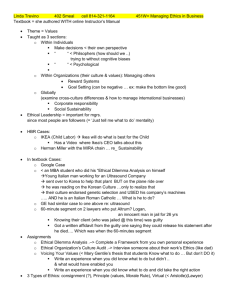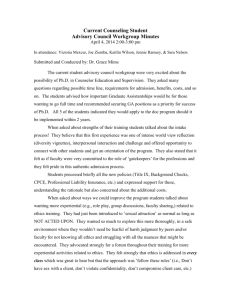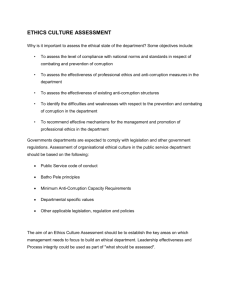Leadership and Ethics - Argosy University Dissertation Site
advertisement

L 7452 Leadership & Ethics Fall I 2007 INSTRUCTOR: STAFF PHONE: EMAIL: FAX: REQUIRED TEXTS: Leading Quietly: An Unorthodox Guide to Doing the Right Thing Author(s) Badaracco, J. L. Copyright (2002). Publisher MA: Harvard Business School Press. 1578514878 ISBN Title Edition Title Author(s) Copyright Publisher ISBN Edition This Course Requires the Purchase of a Course Packet: YES The Ethics of Leadership Cuilla, J. B. (Ed.). (2003). Thomson/Wadsworth 0155063170 NO Argosy University Ed.D Organizational Leadership COURSE SYLLABUS L7452 Leadership & Ethics FACULTY INFORMATION Faculty Name: STAFF Campus: Contact Information: Office Hours: Short Faculty Bio: COURSE DESCRIPTION: This course focuses on theories and models of leadership with special attention to the demonstration of an understanding, familiarity, awareness, and competency of the principles of ethics and how they apply to decision making, leadership, leadership development, and value-based leadership. COURSE PRE-REQUISITES: None REQUIRED TEXTBOOKS: Badaracco, J. L. (2002). Leading Quietly: An Unorthodox Guide to Doing the Right Thing MA: Harvard Business School Press. ISBN: 1578514878 Cuilla, J. B. (Ed.). (2003). The Ethics of Leadership. Thomson/Wadsworth. ISBN: 0155063170 REQUIRED CASES The following cases are available for purchase and downloading through Harvard Business School Press (www.hbsp.hardvard.edu) and are required reading for this class: Martin Marietta—Managing Corporate Ethics (9393016) Accounting Fraud at WorldCom (104071) Hitting the Wall: Nike & International Labor Practices (700047) Martha McCaskey (9403114) TECHNOLOGY: Pentium III CPU/ Windows 98; 128MB RAM, printer; Microsoft Office Acrobat (full version), Microsoft Internet Explorer 5.5 (PC) 5.0 (MAC) or Netscape Navigator 4.08. Norton Antivirus. COURSE LENGTH: 7.5 Weeks CONTACT HOURS: 45 Hours CREDIT VALUE: 3.0 PROGRAM OUTCOMES: 1. Leadership in Teams: Given an organizational situation, identify strategies to develop, maintain, motivate, and sustain selfmanaged teams using concepts, theories and techniques of team leadership. 2. Collaboration in Teams: Given a case study or leadership situation, collect, assimilate, disseminate, and maximize the views of team stakeholders in order to reach defensible goals with minimal conflict. 3. Conflict: Given an organizational situation that requires interpersonal or interdepartmental action, identify situations of conflict, diagnose the impact of both overt and covert behavior, and develop a plan for conflict resolution using evidence-based methods. 4. Ethics: Given an organizational setting, identify ethical and dilemma-resolution practices, and make evidence-based decisions that integrate personal, social, and corporate responsibility. 5. Communication: Communicate orally and in writing to individuals and groups in a concise, clear, organized, and wellsupported manner using formats and technology relevant to the organizational context. 6. Motivation: Given a leadership situation, identify workplace commitment theories to incorporate influences and power as a leader to motivate organizational stakeholders. 7. Research: Given an organizational need to evaluate and defend its actions or potential actions, select, analyze, and apply the assessment techniques, research methods, and/or statistical analyses needed to evaluate and defend those actions based on evidence 8. Knowledge and Understanding of the Field: Demonstrate competency in identifying and integrating the major concepts, theoretical perspectives, historical trends, and key figures in the field of organizational leadership. 9. Change: Evaluate the impact of change on organizations, organizational members, and other stakeholders and apply appropriate change models and theories to facilitate successful change. 10. Global diversity: Analyze and evaluate the involvement of diversity in leadership issues, with special attention to the implications of diversity for individuals, organizations, and societies. COURSE OBJECTIVES: By the end of this course, students will be able to do the following: 1. Evaluate leadership responsibility as it relates to ethics, values, and challenges within an organization. (Program outcome(s) 4, 8) 2. Analyze the relationship between motivation and ethical behavior and how it applies to decision making in the organization.(Program outcome(s) 4, 6) 3. Given several leadership models and theories, apply principles of best practice for leadership development within specific organizational contexts.(Program Outcome 8) 4. Using specific organizational scenarios, compare and analyze the different ethical decision making practices.(Program Outcome 4, 10) 5. Examine ethical dilemmas, analyze the ethical failures of leadership, and utilize appropriate models for making effective ethical decisions. (Program outcome(s) 3, 4, 8) 6. Given various frameworks for ethical decision making, apply the concept of ethics to effective leadership, identifying the differences and interrelationships between values, morals, and ethics, and the characteristics of ethical leadership.(Program outcome 1, 4, 5) 7. Compare scenarios of value based leadership, discuss principles of good practice along with risks and rewards of ethical and value based leadership. (Program outcome 8) ASSIGNMENT TABLE Week Module Topics Readings Introduction to Leadership & Ethics Assigned Articles on Leadership Development—to be determined by faculty 2 Theories of Leadership Assigned Articles—to be determined by faculty 3 Ethics in the Workplace Cuilla: 1 Badaracco: Ch. 1 & 2 1 Assignments (described in detail below) 1. Prepare a 2 – 4 page paper analyzing a current ethical dilemma facing organizational leaders today. What are the primary issues at hand? What are your assumptions or thoughts about how such a dilemma occurs? You do not need to pick a specific organization, leader, or situation. This is more a generic ethical issue (e.g., bribery, nepotism, “cooking the books,” etc) 1. Write a short 3-5 page paper comparing and contrasting two theories of leadership. Describe the main themes of each leadership theory. Which theory would work best in your organization? Explain. 1. Discuss in class a work experience in which your professional integrity was challenged. 2. Read case “Accounting Fraud at WorldCom.” Write a 3-5 page case analysis of what you see as the major ethical issues facing WorldCom. Be prepared to discuss the following questions: What are the implications of this situation for those in leadership roles? What would you have done differently, and why? To what degree does the context or the environment impact/affect the handling of the issues at hand? 4 Ethics and the External Community Cuilla: Ch. 2 Badaracco: Ch. 3 & 4 5 Ethical Development & Personal Responsibility Cuilla: Ch. 3 & 4 Badaracco: Ch. 6 6 The Relationships of Leaders & Followers Cuilla: 5 Badaracco: Ch. 7 1. Read case “Hitting the Wall: Nike and International Labor Practices.” Write a 3-5 page case analysis of what you see as the major ethic issues facing Nike. What are the implications of this situation for the stakeholders (internal or external)? What would you have done differently, and why? Consider the “players” involved, and the actions of those involved in analyzing the case. 2. Submit “Profile of an Effective Leader” paper (details given below) 1. Submit a 2 page Reflection Paper outlining your personal ideas about what it means to be ethical. How did you come to this conclusion? How do you make ethical decisions? Incorporate appropriate theories, models, or philosophical approaches from the course readings into your paper. 2. Class discussion: Read carefully your peer's reflection, and respond with ideas that are directly related to their topics, and then move forward with what the paper brings to mind to you personally. 1. Read and submit a 3-5 page analysis on the case “Martha McCaskey.” How would you describe the framework being used by McCaskey? Is it a useful framework? If so, how? If not, why not? Are there other frameworks that might be more useful? 2. Conduct an interview with a leader in your organization on current issues and challenges facing the organization and what decision making style and ethical framework he/she used in confronting the challenges. 7 8 Ethics & Culture Final assignment Cuilla: 6 Badaracco: Ch. 5 & 8 1. Presentation of Team Leadership & Ethics Audit (details given below) 2. Read the case “Martin Marietta—Managing Corporate Ethics.” Prepare a 3-5 page analysis responding to the following questions: What do you see as the benefits & drawbacks of such an ethics program? Would such a program work in your organization and why or why not? How might you handle some of the employees’ concerns or fears? To what degree do you think the key individuals compromised their ethical principles? When is it ok to do so? When should one not compromise? 1. Final paper due by the last day of the term. Details given below). 2. Review the course objectives, and in a 2-3 page paper, reflect upon what you have learned in terms of the objectives for this course. ASSIGNMENT DETAILS Reflection/Reaction Papers These personal intellectual reflections should summarize the major message and concepts of the readings in a format that is useful to you and fellow co-learners. They are a representation of what is important in understanding the context of the readings. The intent of the reflection papers is to capture your thoughts about several particular ideas, facts, or issues presented and for you to summarize these concepts and theories in a form that will be useful in your intellectual journey. The papers should demonstrate your mastery of the course material and its application in your work life in a thoughtful, clear and well written narrative. Proper citations should be used. Case Studies There will be several cases assigned to read for the class, covering ethical dilemmas faced in organizations. These may be assigned as either individual or team based case analyses. There will be a series of questions about each case that you should respond to. Your case analysis should be no more than 5 pages long. You should use outside sources to support your answers, and they must be properly referenced and written in APA format. The case should be examined & evaluated in light of the ethical frameworks and material studied in this class, as well as what you have learned in other classes. Think of this as a synthesis of your learning. Profile of an Effective Leader Paper Identify someone you consider to be an “effective” leader—from your own life, or someone you have read about. You may either interview this person, or utilize written resources about him/her. Profile this leader, providing insight into his/her leadership style and philosophy, answering questions such as: Who is this person? What has been his/her career path? What are his/her successes and failures? What is his/her leadership philosophy? What are this person’s keys to success? What have some of their ethical dilemmas been? What model, or framework, helps this leader make key ethical decisions? Your paper should be in APA format, and should be no longer than 10 pages long. Leadership & Ethics Audit A leadership and ethics audit on a company of your choice is to be completed by your team. To facilitate access to industry, firm-level and competitor information, this audit will focus on a Fortune 500 company. However, if you wish to perform an audit on a local or regional company, you may do so provided you can obtain all relevant data, and receive my approval beforehand. In performing your analysis, put yourself in the position of a consulting group. You have been hired by the Board of Directors to determine whether the organization's leaders are dealing with a key ethical dilemma effectively, and what can be done to improve the firm’s current strategies of handling the situation. Company Selection Please inform me by the end of the second week which firm you will be performing your leadership and ethics audit on. A firm cannot be audited by more than one team (first come/first serve), and firms whose cases are being analyzed for class cannot be chosen. Please note that your team is responsible for interpreting all case data, e.g. accounting, economic, political, correctly. If you are unsure, please consult the appropriate faculty member. Preliminary Leadership and Ethics audit Report: A preliminary report covering sections 1-3 (as described below) is due in week 5. You will receive feedback to indicate your progress towards the final report. This preliminary report should not exceed 10 pages (excluding appendices). Failure to turn in the progress report on time will result in 10 points being removed from the points received by the team on their final report. Teams that turn in as complete a preliminary leadership and ethics audit (even in bulleted points) as possible tend to do better in this assignment than team that just give something written at the last minute. Format of the Leadership and Ethics Audit: Although your leadership and ethics audit may not adhere completely to the following format, it should follow these steps (though not necessarily in the order listed below): 1. An executive summary (not to exceed 75 words) of the leadership and ethics audit. This summarizes the issues uncovered in your case and your recommendations. 2. Identification and description of the leadership styles and processes in the firm, and a specific ethical dilemma that this firm and the leader you have chosen is currently dealing with. 3. Focus on one leader within the organization. What is your criteria for leadership (note: leadership may not correlate with position in the organization)? How did you select your individual? Why? How would you describe this individual's ethical development? What are the gaps in this individual's leadership and ethical development (if any)? 4. A concise analysis of the leadership issues as they relate to the ethical context you have chosen. Use all applicable theories/frameworks learned in this class to do your analysis. While you are focusing on the ethical journey of this leader, make sure you answer the following questions: How has the organization succeeded and/or failed in developing and empowering your leader over time? What variables influence the type of leadership in this organization and its prevailing ethical climate or ‘spirit’? What processes are in place for the organization (and your leader of choice) that allow and/or inhibit for self-examination and self-reflection? 5. A historical (dynamic) view of the strategies/process pursued by the leader in the firm to deal with this ethical dilemma up to the point of your analysis, their rationale and the reason they worked or did not work. Make sure you relate this section to section 3 above. 6. A detailed implementation plan indicating what the firm will do to deal with the leadership and ethical problems identified. Make sure that your implementation plan includes a time line (over a 1-5 year time period) depending on whether it will a long term or short term plan. How will progress towards the achievement of your goals and objectives be measured? 7. Anticipate and discuss potential internal or external resistance to change. How will you deal with this resistance (if any)? If you do not anticipate resistance, explain why not. 8. Consider the leadership and ethical implications of your implementation plan both at the micro (individual) and macro (organization) levels of analysis and discuss them if necessary. The final report itself should be as concise as possible. It should start with an executive summary addressed to the Board of Directors, quickly move on the audit, and conclude with an implementation plan. Please do not simply copy or paraphrase trade articles. Please do not turn in others’ work as your own. It is not imperative that your whole team agrees upon the interpretation and recommendations of the leadership and ethics audit. A minority report may be attached in an appendix (not more than 2 pages in length) outlining a team member's difference of opinion. The whole paper should not be longer than 20 pages, including appendices. The final leadership and ethics audit will be evaluated according to the following criteria: * Integration of course materials and lectures. * Depth of understanding of leadership and ethical contexts of the firm under study. * Written communication skills (points will be taken off for poor grammar and misspellings). * Coverage of the sections outlined above with respect to the overall format. * Thoroughness of analysis and realism of solutions. GRADING CRITERIA Grading Scale A AB+ B BC+ C- Grading requirements 100 -93 92 - 90 89 - 88 87 - 83 82 – 80 79 – 78 77 – 73 Attendance/participation Reaction Papers Leadership & Ethics Audit Effective Leader Paper Case Analyses (4) Personal Ethics Statement 20% 20% 20% 10% 20% 10% 100% C F 72 – 70 69 and below Library Library Resources: Argosy University’s core online collection features nearly 21,000 full-text journals and 23,000 electronic books and other content covering all academic subject areas including Business & Economics, Career & General Education, Computers, Engineering & Applied Science, Humanities, Science, Medicine & Allied Health, and Social & Behavior Sciences. Many titles are directly accessible through the Online Public Access Catalog at http://library.argosy.edu. All resources in Argosy University’s online collection are available through the Internet. The library will provide students with links, user IDs, and passwords. A detailed list of online resources is located at http://library.argosy.edu/misc/onlinedblist.html. In addition to online resources, Argosy University’s onsite collections contain a wealth of subject-specific research materials searchable in the Online Public Access Catalog. Catalog searching is easily limited to individual campus collections. Alternatively, students can search combined collections of all Argosy University Libraries. Students are encouraged to seek research and reference assistance from campus librarians. Information Literacy: Argosy University’s Information Literacy Tutorial was developed to teach students fundamental and transferable research skills. The tutorial consists of five modules where students learn to select sources appropriate for academic-level research, search periodical indexes and search engines, and evaluate and cite information. In the tutorial, students study concepts and practice them through interactions. At the conclusion of each module, they can test their comprehension and receive immediate feedback. Each module takes less than 20 minutes to complete. Please view the tutorial at http://library.argosy.edu/infolit/ Academic Dishonesty/Plagiarism: In an effort to foster a spirit of honesty and integrity during the learning process, Argosy University requires that the submission of all course assignments represent the original work produced by that student. All sources must be documented through normal scholarly references/citations and all work must be submitted using the Publication Manual of the American Psychological Association, 5th Edition (2001). Washington DC: American Psychological Association (APA) format. Please refer to Appendix A in the Publication Manual of the American Psychological Association, 5th Edition for thesis and paper format. Students are encouraged to purchase this manual (required in some courses) and become familiar with its content as well as consult the Argosy University catalog for further information regarding academic dishonesty and plagiarism. Scholarly writing: The faculty at Argosy University is dedicated to providing a learning environment that supports scholarly and ethical writing, free from academic dishonesty and plagiarism. This includes the proper and appropriate referencing of all sources. You may be asked to submit your course assignments through “Turnitin,” (www.turnitin.com), an online resource established to help educators develop writing/research skills and detect potential cases of academic dishonesty. Turnitin compares submitted papers to billions of pages of content and provides a comparison report to your instructor. This comparison detects papers that share common information and duplicative language. Americans with Disabilities Act Policy It is the policy of Argosy University to make reasonable accommodations for qualified students with disabilities, in accordance with the Americans with Disabilities Act (ADA). If a student with disabilities needs accommodations, the student must notify the Director of Student Services. Procedures for documenting student disability and the development of reasonable accommodations will be provided to the student upon request. Students will be notified by the Director of Student Services when each request for accommodation is approved or denied in writing via a designated form. To receive accommodation in class, it is the student’s responsibility to present the form (at his or her discretion) to the instructor. In an effort to protect student privacy, the Department of Student Services will not discuss the accommodation needs of any student with instructors. Faculty may not make accommodations for individuals who have not been approved in this manner. The Argosy University Statement Regarding Diversity The Argosy University provides equitable access through its services and programs to students of any social, geographic and cultural background, regardless of gender, and strives to prepare all candidates to work with and provide services to diverse populations. Argosy demonstrates its commitment to diversity through the development and support of a diverse educational community.








